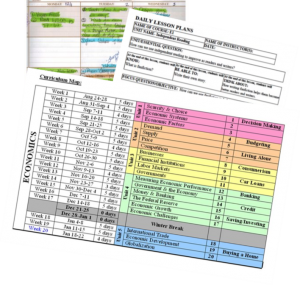Creating a Yearly Curriculum Guide

 This edition of OnPractice may seem a bit counter-intuitive: why publish an article about creating a yearly curriculum guide at the end of the academic year? If you haven’t yet developed this document for the classes you teach, the end of the year is precisely the best (or at least the easiest) time to construct it. You know what you’ve taught, and how long it took to cover each unit. You have a fairly fresh take on what worked and what didn’t, what needed tweaking, or what you think should be added. Yearly curriculum guides are living documents—they are designed to be modified and updated on an ongoing basis. So whether you are creating a plan from scratch, or simply updating an existing plan, we encourage you to take some time to reflect on your experiences over the year and write them down. A thoughtfully designed and up-to-date curriculum guide is one of the most helpful things you can do for yourself—or your successor—and your school at the end of the year.
This edition of OnPractice may seem a bit counter-intuitive: why publish an article about creating a yearly curriculum guide at the end of the academic year? If you haven’t yet developed this document for the classes you teach, the end of the year is precisely the best (or at least the easiest) time to construct it. You know what you’ve taught, and how long it took to cover each unit. You have a fairly fresh take on what worked and what didn’t, what needed tweaking, or what you think should be added. Yearly curriculum guides are living documents—they are designed to be modified and updated on an ongoing basis. So whether you are creating a plan from scratch, or simply updating an existing plan, we encourage you to take some time to reflect on your experiences over the year and write them down. A thoughtfully designed and up-to-date curriculum guide is one of the most helpful things you can do for yourself—or your successor—and your school at the end of the year.Creating a Yearly Curriculum Guide from Scratch
Step 1: Find out what resources your school has available for your subject and grade level already. These may include:
- scope and sequence (a document that lists out what material is covered at each grade level)
- national/organizational grade level standards
- textbooks (and associated teacher guides)
- supplementary materials (such as novels, videos, workbooks, etc.)
- field trip opportunities
- prior course syllabuses and/or teacher lesson plans
Step 2: Determine what material you are required to cover over the course of a year and how much instructional time you will have to do so.
- Look at the number of units you have to teach.
- Examine the school calendar. Count up the approximate number of instructional days that are available throughout the year. (Remember that just because there is school does not mean you’ll have class. You may need to subtract special event days, standardized testing days, etc. from your count. I would also suggest leaving approximately a week at the end of each semester to devote to review and catch up, so don’t count these days in your final count either.)
- Divide the number of days available by the number of units you have to cover. This will give you an approximate guide to how long you have to spend on any one unit.
Step 3: Compile your resources.
- Be sure you have any national/organizational standards you must cover for the year.
 Make a list for each unit of the resources you have available. These could include:
Make a list for each unit of the resources you have available. These could include:
- textbooks
- supplementary texts, videos, articles
- workbooks or lab books
- field trip options/guest speakers
- Keep in mind that this list is a resource guide. At this point it does not need to be complete or comprehensive. You are compiling it so that you have an idea of how much you already have available to help you develop your units. You will develop this more fully when you lesson plan for each unit.
Step 4: Take a closer look at each of your instructional units.
- Are there units which must be taught in a particular order? (In some classes such as maths, language arts, and the sciences, students must master certain content or skills before moving onto other skills. In other classes such as literature, the arts, or social studies, teachers have a greater amount of freedom regarding the order of units.)
- Note if there are any units which are less essential to the students’ overall educational success. These units may be better scheduled towards the end of the semester so that if you run out of time and have to drop a unit, students aren’t missing vital information.
- Note if there are any outside factors that should influence the timing of your units. Examples of this might include:
- if you have a required outdoor field trip, then that unit might be better planned for the fall or spring rather than the winter months.
- if there are elections being held at a particular time, this could influence when you study the electoral process of your host country.
- if your students need to have mastered the skills/standards by a certain time (e.g., before the AP exam or the grade level standardized test).
- Arrange the sequence of your units. Try to ensure that units don’t bleed over into a separate marking period. (This is more important in secondary school and across semesters; primary school and quarterly grading periods allow for a bit more flexibility.)
- Note which units will take longer to teach, and which ones can be covered in a shorter amount of time. (This may be due to the number of skills that must be mastered, the complexity of the content being studied, or the amount of material and/or resources available for each unit.) Adjust the number of instructional days you have allotted each unit accordingly.
- Now go back to your yearly calendar and make these adjustments accordingly.
At this point you have a working yearly curricular guide. You can use this plan to help guide unit and lesson planning throughout the rest of the year. Keep it handy as it will help with pacing and allow future teachers to gauge how much time is available to spend on enrichment and other supplementary activities. Update it as a living document through each school year. This is a gift that future teachers (including yourself) will appreciate when the next school year rolls around!
Click here for a bonus article on creating/updating unit plans.
Photo Credits: Planner. By Evgeny Karandaev, via Shutterstock. Lesson Plans, B.Hunsberger. Teacher's Desk. Sara Robinson, via Shutterstock.
Becky Hunsberger, M.Ed.
Coordinator ofTeacher Education Services
TeachBeyond Global
Coordinator ofTeacher Education Services
TeachBeyond Global
Photo Credits: Planner. By Evgeny Karandaev, via Shutterstock. Lesson Plans, B.Hunsberger. Teacher's Desk. Sara Robinson, via Shutterstock.
